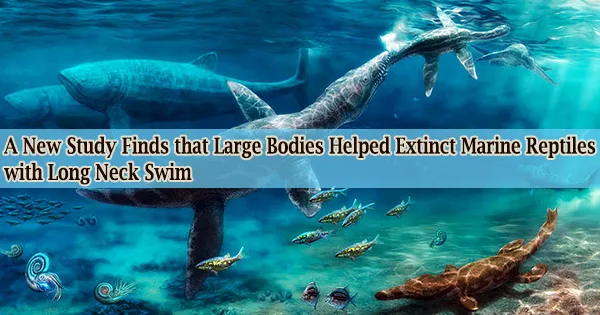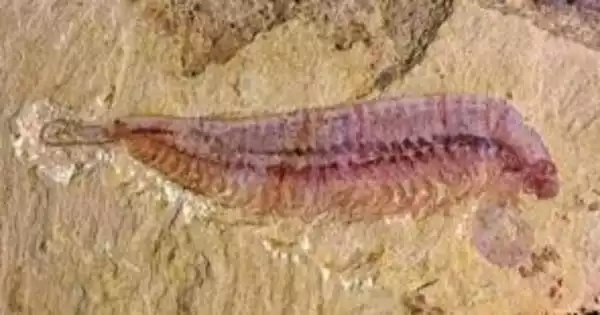Scientists at the University of Bristol have discovered that body size is more important than body shape in determining the energy economy of swimming for aquatic animals. This work, which was published today in Communications Biology, demonstrates that large bodies can help overcome the excess drag caused by extreme morphology, refuting the long-held belief that there is a best body shape for low drag.
The long necks of extinct elasmosaurs did add extra drag, but this was compensated by the evolution of big bodies, according to this study.
Over the last 250 million years, tetrapods, or ‘four-limbed vertebrates,’ have returned to the oceans in a variety of shapes and sizes, ranging from streamlined modern whales over 25 meters in length to extinct plesiosaurs with four flippers and extraordinarily long necks, and even extinct fish-shaped ichthyosaurs.
Dolphins and ichthyosaurs have similar body forms, which have evolved to allow them to move quickly through water with little resistance or drag. Plesiosaurs, on the other hand, existed alongside ichthyosaurs during the Mesozoic Era and had completely distinct bodies.
Their massive four flippers, which they used to fly underwater, and varying neck lengths are unmatched by any living creature. Some elasmosaurs possessed enormous necks, measuring up to 20 feet (6 meters) in length. These necks presumably assisted them in catching fast-moving fish, but they were also thought to slow them down.
Any of a group of long-necked marine reptiles found as fossils from the late Triassic Period to the late Cretaceous Period (215 million to 66 million years ago). Plesiosaurs were found all over Europe and the Pacific Ocean, including in Australia, North America, and Asia.
This study shows that, in contrast with prevailing popular knowledge, very long necked plesiosaurs were not necessarily slower swimmers than ichthyosaurs and whales, and this is in part thanks to their large bodies. We found that in elasmosaurs, neck proportions changed really fast.
Dr. Tom Stubbs
It was previously unknown how form and size affected the energy demands of swimming in these various marine species. The research was led by palaeobiologist Dr. Susana Gutarra Daz of Bristol’s School of Earth Sciences and the National History Museum of London: “To test our hypotheses, we created various 3D models and performed computer flow simulations of plesiosaurs, ichthyosaurs and cetaceans. These experiments are performed on the computer, but they are like water tank experiments.”
Dr. Colin Palmer, an engineer involved in the project said: “We showed that although plesiosaurs did experience more drag than ichthyosaurs or whales of equal mass because of their unique body shape, these differences were relatively minor. We found that when size is taken into account, the differences between groups became much less than the shape differences. We also show that the ratio of body length to diameter, which is widely used to classify these aquatic animals as more or less efficient, is not a good indicator of low drag.”
Dr. Gutarra Díaz said, “We were also particularly interested in the necks of elasmosaurs and so, we created hypothetical 3D models of plesiosaurs with various lengths of necks. Simulations of these models reveal that past a certain point, the neck adds extra drag, which potentially would make swimming costly. This ‘optimal’ neck limit lies around twice the length of the trunk of the animal.”
Dr. Benjamin Moon, another collaborator and expert on marine reptiles, continued:
“When we examined a large sample of plesiosaurs modelled on really well preserved fossils at their real sizes, it turns out that most plesiosaurs had necks below this high-drag threshold, within which neck can get longer or shorter without increasing drag. But more interestingly, we showed that plesiosaurs with extremely long necks also had evolved very large torsos, and this compensated for the extra drag!”
Dr. Tom Stubbs, another co-author summarised: “This study shows that, in contrast with prevailing popular knowledge, very long necked plesiosaurs were not necessarily slower swimmers than ichthyosaurs and whales, and this is in part thanks to their large bodies. We found that in elasmosaurs, neck proportions changed really fast.”
“This confirms that long necks were advantageous for elasmosaurs in hunting, but they could not exploit this adaptation until they became large enough to offset the cost of high drag on their bodies.”
Professor Mike Benton, also part of the research, commented: “Our research suggests that large aquatic animals can afford to have crazy shapes, as in the elasmosaurs. But there are limits: body sizes cannot get indefinitely large, as there are some constraints to very large sizes as well.”
“The maximum neck lengths we observe, seem to balance benefits in hunting versus the costs of growing and maintaining such a long neck. In other words, the necks of these extraordinary creatures evolved in balance with the overall body size to keep friction to a minimum.”
















